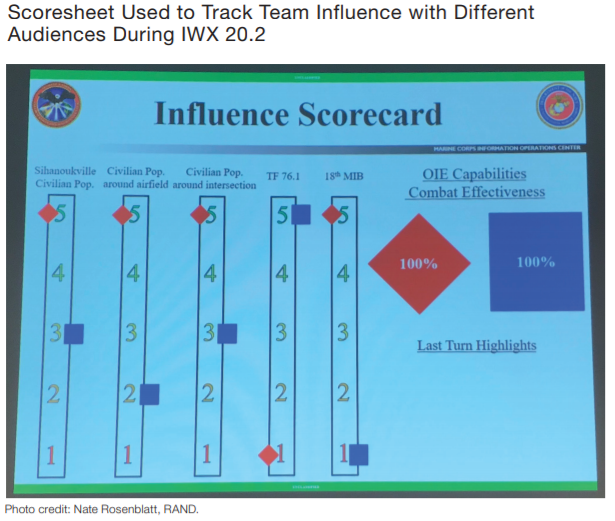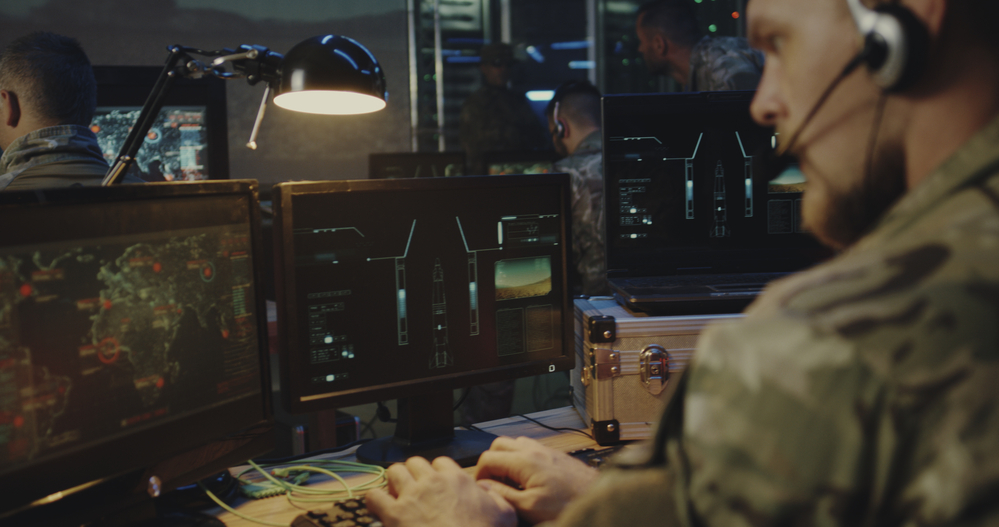The US military plans wargames designed to influence and deceive foreign target audiences while the US government wages its own influence campaign against perceived domestic extremism at home.
On Tuesday, RAND published the US Marine Corps-sponsored “Information Warfighter Exercise Wargame Rulebook,” highlighting the following objectives for an upcoming wargame:
- Influence foreign target audiences
- With secondary emphasis on deceive foreign target audiences
- Inform domestic and international audiences
- And sometimes, depending on the mix of participants, attack and exploit networks, systems, and information
While foreign audiences are a primary target of this particular training exercise, what’s to stop the lessons learned from being used to influence and deceive domestic audiences?
“Military Deception is actions executed to deliberately mislead adversary military, paramilitary, or violent extremist organization decision makers, thereby causing the adversary to take specific actions (or inactions) that will contribute to the accomplishment of the friendly mission” — Joint Chiefs of Staff Military Deception Report, 2017
With the twentieth anniversary of 9/11 just around the corner, the Department of Homeland Security (DHS) recently updated its terrorism threat advisory to label Americans who oppose COVID-related government restrictions and those who believe there was fraud in the 2020 presidential election as potential domestic terror threats.
Military deception seeks to deliberately mislead people who are labeled “violent extremists.”
If people who protest government restrictions are considered extremists, would it stand to reason that the government would mislead them in order to defeat them as a matter of policy, or are US citizens exempt?
“DHS is also advancing authoritative sources of information to debunk and, when possible, preempt false narratives and intentional disinformation” — DHS National Terrorism Advisory, August, 2021
DHS Advisory Lists Opponents of COVID Restrictions as Potential Terror Threats #terrorThreats #crownhttps://t.co/5t4lflzeKP pic.twitter.com/pdfIOUPT9b
— Crown Financial (@Crown_Financial) August 17, 2021
According to the terrorism threat advisory, “DHS will continue to identify and evaluate calls for violence, including online activity associated with the spread of disinformation, conspiracy theories, and false narratives, by known or suspected threat actors and provide updated information, as necessary.”
While the American government vows to crack down on disinformation at home, the American military is training to use disinformation as a weapon abroad.
“War is, ultimately, a contest of opposing, independent, and irreconcilable wills” — Information Warfighter Exercise Wargame Rulebook
Marine Corps doctrine centers on the idea that “will to fight” is the single most important factor in war.
According to the wargames rulebook, Operations in the Information Environment (OIE), such as deceiving and influencing foreign audiences, are “particularly useful in attacking will to fight.”
As far as truth is concerned, all bets are off in this type of information warfare where the objective is to destroy the enemy through deception and influence peddling.
To accomplish their wargaming objectives, two teams of players will compete against each other “in-and-through the information environment” to better support their respective sides over the course of the three-day wargame.
“Wargaming remains an important tool for operators and for policymakers for learning, exploring, and thinking through potential consequences of planned or conceivable operations” — Information Warfighter Exercise Wargame Rulebook
To spice things up a bit, the rulebook allows for unexpected scenarios called “injects” to be inserted into the wargame, and it gives a set of very specific examples of what those may look like.
Among the injects are scenarios that could also be applied to a multitude of domestic situations anywhere in the world:
- A key influencer is accidentally killed by the operations of one of the two sides
- A key leader of part of one of the subordinate formations is killed in combat, or is relieved with cause, and either leaves that formation rudderless (and perhaps more vulnerable) or is replaced by a new leader who has different proclivities
- International outrage descends on one side because of reports of atrocities (whether or not these accusations are true and who made them might be pointed RFIs [requests for information])
- Something about the operation or the response leads to protest in area (peaceful or otherwise)
- The presence of noncombatants in the area is much higher than intelligence suggested because of a new local shrine (or an unanticipated local holiday or festival, or some other reason), and this increased presence is a threat to operational progress for one or both sides
- A commander or leader on one side is embroiled in some kind of personal scandal that breaks in the news today
- Rolling power outages restrict internet and mobile phone availability across part of the area of responsibility (even where batteries are charged, the towers are dark)
The name of the game is for teams to spin the information to their advantage as they attempt to deal with situations like protests, public backlash over controversial actions, the loss of a key influencer, or personal scandals.

Influence Scorecard Example. Image Source: The Information Warfighter Exercise Wargame Rulebook
“Military Deception can mask, protect, reinforce, exaggerate, minimize, distort, or otherwise misrepresent US technical and operational capabilities, intentions, operations, and associated activities” — Joint Chiefs of Staff Military Deception Report, 2017
Leaving no stone unturned, the two teams will have to methodically describe every detail they put into their disinformation campaigns.
With a focus on efforts to influence, inform, or deceive in support of operations, teams of players must:
- Clearly describe their target, target audience (TA), or audience and the desired effect on that audience
- Continually reassess the information environment and contend with unavoidable ambiguity in the information environment
- Articulate how selected information-related capabilities (IRCs) are to be deployed and offer reasons for the effectiveness of their employment
- Explain how proposed actions affect the target TA, or audience and how that effect supports their side’s scheme of maneuver and overall mission success
- Verbally present their moves in a clear, concise, and well-thought-out statement with appropriate supporting justifications
- Defend the argument for the success of their actions against the counterarguments of their opponent, if required
- Present verbal counterarguments to their opponents’ presented actions
According to the rulebook, “Wargaming remains an important tool for operators and for policymakers for learning, exploring, and thinking through potential consequences of planned or conceivable operations.”
All the detail put into the planning and execution will be assessed for use in real-world situations.
The primary objective of this particular wargame is for teams “to learn how to influence, inform, or deceive in support of operations.”
Secondary goals are for participants “to continue to develop OIE-related planning skills that will aid them when they return to their home units and when they participate in real operational planning teams in the future.”
“DHS will continue to identify and evaluate […] online activity associated with the spread of disinformation, conspiracy theories, and false narratives, […] and provide updated information, as necessary” — DHS National Terrorism Advisory, August, 2021
The White House considers domestic terrorism as “the most urgent terrorism threat the United States faces today,” and the US government views Americans who share grievances against lockdowns, mandatory vaccinations, and other restrictions as potential domestic terror threats.
Under the National Strategy for Countering Domestic Terrorism, the administration is trying to understand “how foreign malign influence operations and the dissemination of disinformation, including by foreign governments, relate to the domestic terrorism threat we face.”
At the same time, “DHS is advancing authoritative sources of information to debunk and, when possible, preempt false narratives and intentional disinformation, and providing educational materials to promote resilience to the risks associated with interacting with and spreading disinformation, conspiracy theories and false narratives.”
So, while the military is learning how to deceive foreign audiences, the government is actively engaging in information campaigns to influence domestic audiences.
What is the purpose of deception if not to influence an intended outcome?
Can the two be mutually exclusive? How blurry is the line between them?
Google-backed RAND report recommends infiltrating & subverting online conspiracy groups from within
DARPA to ‘exploit social media, messaging & blog data’ to track geopolitical influence campaigns
Intel agency awards contract to company that harvests social media text, data
Big tech COVID-19 surveillance data & censorship threaten privacy & free speech: op-ed
Prepping for a cyber pandemic: Cyber Polygon 2021 to stage supply chain attack simulation











